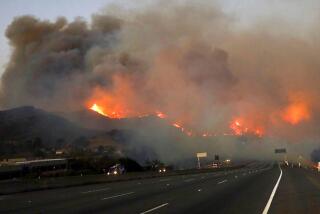Crowd Protests Fallbrook School Tax : Education: Audience of mostly senior citizens says the special assessment for recreational upgrading would circumvent voters.
- Share via
More than 350 protesters packed the Fallbrook High School gymnasium Monday night to urge school board members to vote down a special assessment district.
The protesters--overwhelmingly senior citizens--argued that the proposed tax, which does not require voter approval, circumvents the will of the electorate.
“I think the whole process by the board is un-American,” Margaret Bartlett said.
Many complained that the money raised would not go to classrooms or libraries but to recreational facilities.
“The whole problem with Fallbrook High School is giving a good education, and I don’t think swimming pool repairs come before libraries,” Bartlett told the board.
A small group of parents and teachers showed up to support the assessment district.
“I’m thirtysomething, and I’m very disappointed that there aren’t more thirtysomethings out here,” Bob Lucy said.
“I find it very sad that this has become one generation versus another.”
The proposal would raise $3.7 million to pay for sports and recreational facilities at the high school, and would tax homeowners up to $24 a year and commercial property owners $12 a year for up to 30 years.
Although funds collected under the act by school districts can be used for such things as baseball fields, basketball courts, tracks and gymnasiums, they cannot be used for classrooms, books or salaries.
The district turned to the special tax as a last resort after two bond elections in the past year were defeated and the 35-year-old school’s enrollment soared to almost double the 1,200 it was designed to accommodate.
The plan, however, ignited a revolt by property owners and started grumblings about a possible recall election. Opposition forces said they have collected as many as 2,000 signatures to dissuade trustees from approving the assessment.
The tax, which has been used by cities and water districts around the state since the Lighting and Landscaping Act was written into law in 1972, has only recently been applied by financially strapped school districts.
The assessment must be approved by a majority of the school board and does not require voter approval, although, if the school board determines that a majority of property owners are against the assessment, then it must receive votes from at least four of the five board members to be implemented.
Many cities and counties in the state use the assessments to finance improvements in specific areas. The street lights in Fallbrook, for example, are paid for by an assessment district imposed by the county.
School board members in the Escondido Union High School District in June rejected a similar proposal, with several of the members saying they felt uncomfortable with the idea of raising a tax that had not gone before the voters.
Before passage of Proposition 13 in 1978, however, it was not unusual for school districts to raise taxes.
“It’s a different culture now. Board members aren’t experienced in taking this kind of heat” from taxpayers, said Scott Plotkin, president-elect of the California School Board Assn.
“To most school board members, especially those that were elected after 1978, any notion of them having taxing authority is totally foreign to them,” he said.
Conversely, taxpayers, who before Proposition 13 felt they had no option but to accept school and other districts’ decisions to raise money, are now rebelling against taxes of all kinds.
Voters in Fallbrook have twice in the past year shot down general bonds, which require a two-thirds vote to be approved. The first bond measure, which was for $35 million and would have renovated Fallbrook High and built a second high school, lost by about 100 votes in June, 1990. A similar measure failed the following November.
More to Read
Sign up for Essential California
The most important California stories and recommendations in your inbox every morning.
You may occasionally receive promotional content from the Los Angeles Times.













